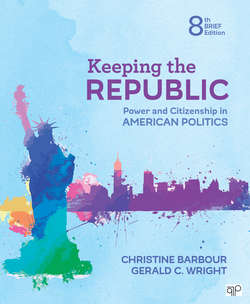Читать книгу Keeping the Republic - Christine Barbour - Страница 51
На сайте Литреса книга снята с продажи.
Let’s Revisit: What’s at Stake . . . ?
ОглавлениеWe began this chapter by looking at the power of hashtag activism in response to the phenomenal effort of the Parkland students to change the prevailing narrative about guns, increase the involvement of young people in politics, and bring about political change. We asked whether Benjamin Franklin would consider such movements as fulfilling his admonishment to keep the republic. Since then, we have covered a lot of ground, arguing that politics is fundamental to human life and, in fact, makes life easier for us by giving us a nonviolent way to resolve disputes. We pointed out that politics is a method by which power and resources get distributed in society: politics is who gets what and how they get it. Citizens who are aware and involved stand a much better chance of getting what they want from the system than do those who check out or turn away. One clear consequence when young people disregard politics, then, is that they are far less likely to get what they want from the political system. This is exactly what happens.
But the hashtag activists we met in this chapter have been instrumental in changing the narrative of contemporary American politics. As Occupy protester Matt Brandi says:
The objective of Occupy was to change the direction of the national dialogue and debate. . . . By appearing in strong numbers and generating media interest (both new/social and commercial/mass), Occupy was able to influence the national dialogue. We protested about inequality and exploitation, the corruption of our government by wealth and influence; and while we did not make “demands,” people began to talk about inequality, exploitation, and the corruption of democracy. The very way people talked and thought about these issues changed.
What Matt is suggesting was at stake for the Occupy protesters was, in the language of political scientists, agenda setting. A problem not defined as a problem, or not on the national agenda, cannot be solved by public action. It worked for the Occupy protestors who saw income inequality become a major issue between President Obama and his 2012 Republican challenger, Mitt Romney
It was that effort to change the narrative, and to put real political effort behind it, that encouraged the kids in the March for Our Lives project to spend the summer registering young people and getting them fired up to vote for changes in the gun laws. Although the gun laws remain stubbornly the same, the narrative has begun to change. Young people voted in huge numbers for a midterm election and the policy change is likely to follow the change in narrative.
In the same way, the It Gets Better Project helped change the narrative on both bullying and gay rights. In the years since the movement began in 2011, as more and more “mainstream” people have posted videos promising LGBT youth that it does indeed get better, the world in fact has gotten better. Certainly, the It Gets Better Project was not solely responsible for these changes, but in significant ways it helped change the narrative that made the changes possible.
And the debates over systemic racism and intersectionality in the 2016 election, at least on the Democratic side, make clear that Black Lives Matter had changed the narrative on race, too. President Obama had been cautious about making race a centerpiece of his administration, but his presidency and the BLM movement freed Hillary Clinton, as candidate, to address it in a more comprehensive way.
These movements highlight the value of grassroots action, and the power of stepping outside the system to put pressure on the status quo to respond to unmet and even previously unvoiced needs. It might not have been what Benjamin Franklin had in mind, but occupying the republic may very well be another means of keeping it.
Want a better grade?
Get the tools you need to sharpen your study skills. SAGE edge offers practice quizzes, eFlashcards, video, and multimedia at edge.sagepub.com/barbour9e.
Review
